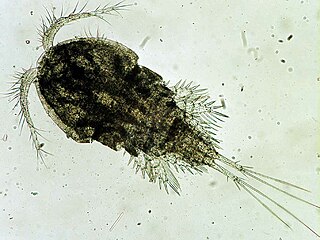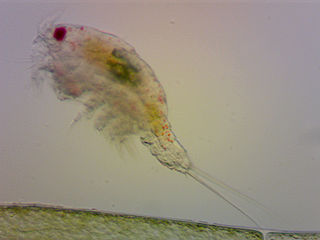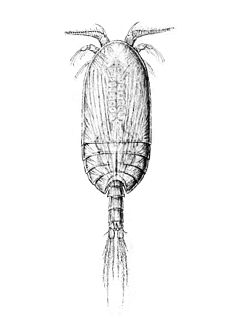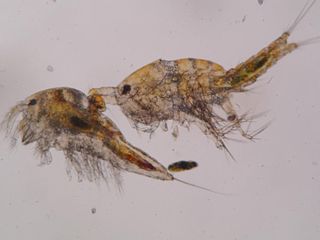Related Research Articles

The Cyclopoida are an order of small crustaceans from the subclass Copepoda. Like many other copepods, members of Cyclopoida are small, planktonic animals living both in the sea and in freshwater habitats. They are capable of rapid movement. Their larval development is metamorphic, and the embryos are carried in paired or single sacs attached to first abdominal somite.

Calanus is a genus of marine copepod in the family Calanidae. The genus was split in 1974, with some species being placed in a new genus, Neocalanus. The following species are recognised:

Attheyella is a genus of copepods in the family Canthocamptidae, containing the following species:
Leptocaris is a genus of copepods in the family Darcythompsoniidae. One species, the Mexican endemic L. stromatolicolus, is included on the IUCN Red List as a vulnerable species. The genus contains the following species:
Nitocrella is a genus of copepod. Although most other genera in the family Ameiridae are marine, species of Nitocrella are almost exclusively found in subterranean fresh water or brackish water. More than 80 species are included in the genus, including two which are listed as vulnerable species on the IUCN Red List:

Canthocamptidae is a family of copepods. Most of the 700 species are confined to fresh water, although there are also marine species. It contains the following genera:

Acartia is a genus of marine calanoid copepods. They are epipelagic, estuarine, zooplanktonic found throughout the oceans of the world, primarily in temperate regions.
Karl Georg Herman Lang was a Swedish zoologist, specialising in crustaceans, especially harpacticoid copepods and tanaids. He was born in Malmö and gained a doctoral degree from the Lund University in 1924. He spent much of his early career working as a teacher in elementary schools in Eslöv, Lund and Stockholm. From 1947 to 1967, Lang worked at the Swedish Museum of Natural History, eventually reaching the position of head of the Section of Invertebrate Zoology. As well as many papers on Harpacticoida up to 1965, and many papers on Tanaidacea throughout his life, Lang also published on Priapulida and Kinorhyncha, and a single paper on isopod crustaceans. He had few students, and his writings were "painfully detailed" and introduced long names such as Paraphyllopodopsyllus and Pseudoleptomesochrella.
Cletocamptus is a genus of marine and brackish-water copepods, containing the following species:
Robertgurneya is a genus of copepods, containing the following species:

Platycopiidae is a family of copepods. Until the description of Nanocopia in 1988, it contained the single genus Platycopia. It now contains four genera, three of which are monotypic; the exception is Platycopia, with 8 species.
Darcythompsoniidae is a family of copepods, containing four genera. Members of the family have a very wide distribution throughout the tropics, where they live in rotting mangrove leaves. They lack egg sacs and are thought to lay their eggs directly into the leaf litter.
Metridinidae is a family of copepods, comprising three genera – Gaussia, Metridia and Pleuromamma. It has also been referred to as "Metridiidae", but following a petition to the International Commission on Zoological Nomenclature, that name has been restricted to the family Metridiidae Carlgren, 1893, based on the anthozoan genus Metridium. All species in the family can produce blue-green bioluminescence; the light is produced in glands, whose position varies between genera.
Pennella is a genus of large copepods which are common parasites of large pelagic fishes. They begin their life cycle as a series of free-swimming planktonic larvae. The females metamorphose into a parasitic stage when they attach to a host and enter into its skin. The males are free swimming. Due to their large size and mesoparasitic life history there have been a number of studies of Pennella, the members of which are among the largest of the parasitic Copepoda. All species are found as adults buried into the flesh of marine bony fish, except for a single species, Pennella balaenopterae which can be found in the muscles and blubber of cetaceans and occasionally other marine mammals, and is the largest species of copepod.
Procolobomatus is a genus of copepod, containing the following species:
Tracheliastes is a genus of parasitic copepods, containing the following species:

Harpacticidae is a family of copepods, containing the following genera:
Karllangia pulchra is a species of marine copepod.
Karllangia arenicola is a species of marine copepod. It is the type species of the Genus Karllangia. The species was described by Noodt in 1964.
Heterocope is a genus of copepods in the family Temoridae. It was described by Norwegian biologist Georg Ossian Sars in 1863. The World Register of Marine Species lists the following currently accepted species:
References
- ↑ Rony Huys (2009). "Unresolved cases of type fixation, synonymy and homonymy in harpacticoid copepod nomenclature (Crustacea: Copepoda)" (PDF). Zootaxa . 2183: 1–99. ISBN 978-1-86977-399-1.
- ↑ Åke Andersson & F. D. Por (1977). "Karl Georg Herman Lang (1901–1976)". Crustaceana . 33 (2): 210–214. doi:10.1163/156854077X00124. JSTOR 20103218.
- ↑ T. Chad Walter (2008). Walter TC, Boxshall G (eds.). "Karllangia Noodt, 1964". World of Copepods database. World Register of Marine Species . Retrieved March 2, 2010.